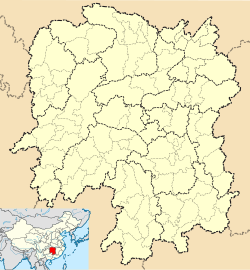Jinzhu (Chinese: 金竹镇) is a town in Huitong County, Hunan, China.[1][2][3] As of the 2023 census it had a population of 20,450 and an area of 201.52-square-kilometre (77.81 sq mi).[1]
Jinzhu
金竹镇 | |||||||
|---|---|---|---|---|---|---|---|
 Residential buildings in Jinzhu Town | |||||||
| Coordinates: 27°00′41″N 109°50′30″E / 27.011289°N 109.841649°E | |||||||
| Country | People's Republic of China | ||||||
| Province | Hunan | ||||||
| Prefecture-level city | Huaihua | ||||||
| County | Huitong County | ||||||
| Designated (town) | 2015 | ||||||
| Area | |||||||
| • Total | 201.52 km2 (77.81 sq mi) | ||||||
| Population (2019) | |||||||
| • Total | 20,450 | ||||||
| • Density | 100/km2 (260/sq mi) | ||||||
| Time zone | UTC+08:00 (China Standard) | ||||||
| Postal code | 418305 | ||||||
| Area code | 0745 | ||||||
| Chinese name | |||||||
| Simplified Chinese | 金竹镇 | ||||||
| Traditional Chinese | 金竹鎮 | ||||||
| |||||||
Administrative division
editAs of 2021, the town is divided into fifteen villages:
- Jinping (金坪村)
- Tongmu (桐木村)
- Yanjiao (岩脚村)
- Huangtuba (黄土坝村)
- Qingjiang (清江村)
- Diling (地灵村)
- Shiqi (石其村)
- Shuiwei (水尾村)
- Xiaojia (肖家村)
- Wangjia (王家村)
- Dongyue (东岳村)
- Loujiao (楼脚村)
- Pojiao (坡脚村)
- Banshan (半山村)
- Laotuan (老团村)
History
editDuring the Republic of China, it belonged to Jinzhu Township (金竹乡), Anhuai Township (安怀乡), Xiongxi Township (雄溪乡), and Shuangxi Township (双溪乡).[4]
After the founding of the Communist State, in 1950, it came under the jurisdiction of the 2nd District of Huitong County.[5] Its name was changed to Buzi District (堡子区) in June 1955.[5] In 2015, Xiaojia Township (肖家乡) and Jinlong Township (金龙乡) merged to form Jinzhu Town.[6]
Geography
editThe town is located on the northeast of Huitong County.[1] It shares a border with Buzi Town to the west, Ruoshui Town to the east, Ma'an Town and Hongjiang to the north, and Lincheng Town to the south.[1]
Economy
editThe economy is supported primarily by agriculture and forestry.[7] Its economy is dominated by Phyllostachys edulis.[8][9] The region has an abundance of coal and gold.[1]
Demographics
editAs of 2019, the National Bureau of Statistics of China estimates the town's population now to be 20,450.
| Year | Pop. | ±% |
|---|---|---|
| 2011 | 20,403 | — |
| 2018 | 20,431 | +0.1% |
| 2019 | 20,450 | +0.1% |
| Source: [10] | ||
References
edit- ^ a b c d e Li Liguo, Yu Changming & Duan Linyi 2015, pp. 2839–2840.
- ^ Hu Jiangyong (胡江勇); Zhen Xufei (甄叙斐) (12 October 2023). 【视频】“中国楠竹之乡”金竹镇:打造“六宜”楠竹特色小镇. htnews.cn (in Chinese). Retrieved 29 February 2024.
- ^ Tang Jiaxing (唐家兴); Tang Shui (汤水) (1 March 2023). 奋进的春天 会同县金竹镇:村企联建谋发展,“绿色黄金”遍地生. hunantoday.cn (in Chinese). Retrieved 29 February 2024.
- ^ Wu, Xianqing 2012, p. 20.
- ^ a b Wu, Xianqing 2012, p. 21.
- ^ 怀化撤并93 个乡镇 你家乡变了没. Sohu (in Chinese). 3 December 2015. Retrieved 25 March 2024.
- ^ Yang Lingxia (杨伶霞) (14 October 2023). “中国楠竹之乡”会同金竹镇:打造“六宜”楠竹特色小镇. sina (in Chinese). Retrieved 29 February 2024.
- ^ Hu Jiangyong (胡江勇) (9 October 2023). 会同金竹镇入选“中国南竹之乡”. qq.com (in Chinese). Retrieved 29 February 2024.
- ^ Yang Jun (杨军) (6 April 2022). 桃江马迹塘镇村民冬天挖冬笋、春天挖春笋——“竹业小镇”竹笋飘香. hnrb.voc.com.cn (in Chinese). Retrieved 29 February 2024.
- ^ National Bureau of Statistics of China, ed. (2021). 中国县域统计年鉴·2020 [China County Statistical Yearbook in 2020] (in Chinese). Beijing: China Statistical Publishing House. p. 379. ISBN 9787503794735.
Bibliography
edit- Li Liguo; Yu Changming; Duan Linyi, eds. (2015). 中华人民共和国政区大典湖南省卷 [Volume of Hunan of the Encyclopedia of the People's Republic of China] (in Chinese). Beijing: China Social Publishing House. ISBN 9787508748160.
- Wu, Xianqing, ed. (2012). 会同县概况 [General Situation of Huitong County] (in Chinese). Beijing: Nationalities Publishing House. ISBN 978-7-105-12473-2.
